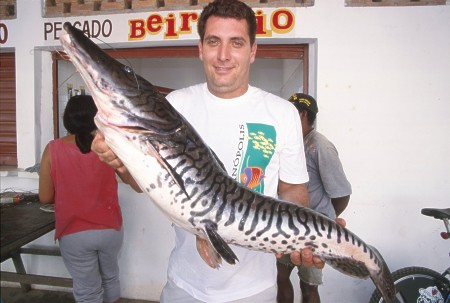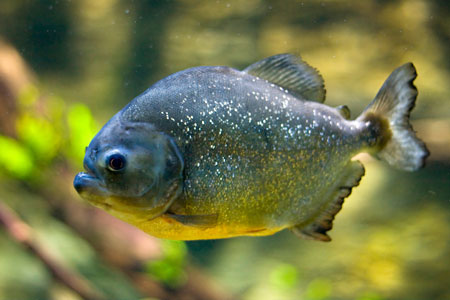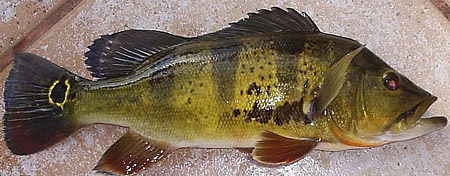Tucunaré
Tucunaré, or Peacock Bass, are native to the waterways of the Amazon. They're now being found in the Pantanal but are regarded as an invasive species since their voracious appetite has seen them decimate native fish populations in other areas.
The species arrived in Pantanal rivers in the 1980s - reputedly as the result of a failure in a tank at a fish farm along the upper Piquiri river near Rondonópolis. In the mid-90s they were still restricted largely to Itiquira and Piquiri rivers near the divisor between Mato Grosso and Mato Grosso do Sul - however they have now reached further south into areas around Corumbá.
Although highly valued as a sports fish there were strong fears that Tucunaré, as an invasive species, would decimate other local species. This was observed to occur in areas of southeastern Brazil where Tucunaré had been introduced - with a reported 95 percent decline in native fish density, and 80 percent decline in overall diversity within two years. Fortunately this appears not to have been the case in the Pantanal - where the very high diversity of fish species appears to have prevented it from becoming too dominant. Instead t is merely the newest arrival in an environment already with over 260 species of fish.
The secret for Tucunaré achieving dominance in new environments is that they're highly protective of their young. Eggs are deposited, and spawn are raised, in safe areas behind river stones - which ensures a high survivability rate. However, they have a huge appetite and are fierce towards another fish meaning that the fry of other fish species (such as pintado, pacu, dourado and jaú) are subsequently much less likely to survive. Once other prey species are eliminated, Tucunaré resort to cannibalism - eating fry of their own kind.
Although highly valued as a sports fish there were strong fears that Tucunaré, as an invasive species, would decimate other local species. This was observed to occur in areas of southeastern Brazil where Tucunaré had been introduced - with a reported 95 percent decline in native fish density, and 80 percent decline in overall diversity within two years. Fortunately this appears not to have been the case in the Pantanal - where the very high diversity of fish species appears to have prevented it from becoming too dominant. Instead t is merely the newest arrival in an environment already with over 260 species of fish.
The secret for Tucunaré achieving dominance in new environments is that they're highly protective of their young. Eggs are deposited, and spawn are raised, in safe areas behind river stones - which ensures a high survivability rate. However, they have a huge appetite and are fierce towards another fish meaning that the fry of other fish species (such as pintado, pacu, dourado and jaú) are subsequently much less likely to survive. Once other prey species are eliminated, Tucunaré resort to cannibalism - eating fry of their own kind.
Despite potentially being environmentally destructive, Peacock Bass, are a good eating fish popular with sports fishing enthusiasts. Credit: LuisGomez111
Appearance
Tucunaré, or Peacock Bass, are yellow-green with 3-5 dark vertical bars depending on subspecies. Those in the Pantanal are Cichla piquiti, or Blue Peacock Bass, which are discernible by their blue-tinged belly and fins. Adults reach up to 50 cm in length- although the males are typically larger than females. Tucunaré have a spot on their tail resembling an eye. This marking is a common feature in South American cichlids species (such as the Astronotus ocellatus or "Oscar") and is believed to deter predators such as piranha. Some adult fish develop as noticeable hump on their forehead during the rainy season when the first spawn.
Notes for Fishing
Tucunaré are prized by sports fishermen for their strong fighting qualities. They are also a good eating fish, with flesh that is white and sweet when cooked, and not excessively bony. It has very little oil, making it similar in taste to snapper or grouper.
Related Links
Scientific Name
Cichla piquiti

Local Name
Tucunaré

Description
Yellow-green with 3-5 dark vertical bars depending on subspecies, and a dark spot on their tail resembling an eye. Species in the Pantanal typically have blue-tinged belly and fins. Adults reach up to 50 cm in length
Behaviour and Habitat
Unlike many other Pantanal species, such as Pintado and Dorado, Tucunaré don't migrate to reproduce. They prefer to inhabit clean still waters, lakes, and ponds - but will migrate in search of food, with their expansion into new areas being facilitated by seasonal flooding when rivers and lakes become interconnected.
Tucunaré prey on smaller fish, with studies suggesting that they are generalist and opportunistic in their diet - preying on whatever comes their way. In addition to fish they eat shrimps, plant debris, and fish eggs likely through the predation of nests.
Reproduction
Within the Pantanal, Tucunaré reproduce through October to March - which is the same piracema (spawning) period common for most other regional fish. This marks the end of the dry season, when water levels are at their lowest - and when the start to arrive with the rains of the wet season. This helps ensure that, when they hatch from the eggs, the fry emerge into an environment with plentiful food and where the lacks and rivers are interconnected to facilitate dispersal.
Tucunaré lay their eggs on the riverbed, often in protected spaces behind rocks. Both parents remain nearby for several months to protect the eggs and their offspring. Groups of young tucunaré can sometimes be seen swimming together alongside one of the parents.
Conservation and Threats
Tuncunaré are hardy and adaptable, and the protection of their eggs and young by their parents gives them an advantage compared to many other fish species. This gives them a high survival rate - so much so that they can become a problem when introduced into new environments. In this circumstance they may become an invasive species that quickly displaces other locally native species. However, as a tropical species, their range is limited by water temperature.
Quick Facts
- Tuncunaré/Peacock Bass make for great aquarium fish if you have a large enough aquarium.
- When kept as an aquarium fish, tucunaré spawn several times a year instead of following their natural annual reproductive cycle.
- Tucunaré were released into other regions of Brazil in the 1960s and 70s with the creation of new hydro lakes. This was done to control large numbers of piranha which built up due to the lack of other natural (migratory) predators such as dorado, pintado and pacu.








Banner image: Tucunare or Peacock Bass (iStock/Fernando Podolski).
Footer images: Piranha teeth (Shutterstock/Chris Howey); Red-Bellied Piranha (Shutterstock/kostudio); Cachara catfish in Pantanal market (Andrew Mercer)

Pantanal Escapes